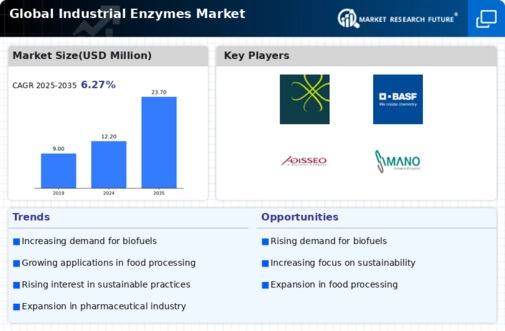Market Share
Industrial Enzymes Market Share Analysis
The Industrial Enzymes Market is a dynamic and competitive landscape where companies employ various market share positioning strategies to gain a competitive edge. These strategies are essential for businesses operating in the sector to expand their reach, increase profitability, and establish a robust market presence. The Asia-Pacific market is forecasted to exhibit the most substantial Compound Annual Growth Rate (CAGR) throughout the projected period. This dynamic trajectory is notably driven by robust growth anticipated in key markets within the region, namely China, Japan, and Australia. These nations are poised to record remarkable and sustained rates of expansion during the forecasted period. The heightened growth rates in these markets can be attributed to a confluence of factors, including evolving consumer preferences, increasing disposable incomes, and a growing awareness of product quality and safety.
China, as a pivotal player in the Asia-Pacific landscape, is expected to contribute significantly to the regional upswing. The burgeoning middle-class population in China, coupled with a heightened emphasis on food safety and quality, is fostering a substantial demand for products with protective cultures. Similarly, Japan and Australia are also anticipated to exhibit strong growth, propelled by a combination of factors such as changing dietary preferences and a discernible shift towards healthier and safer food options.
This outlook underscores the significance of the Asia-Pacific market in the global landscape of protective cultures, emphasizing its role as a major growth engine. The region's potential for robust expansion signifies its pivotal position in shaping the trajectory of the protective cultures market on a global scale. One prevalent strategy employed by companies in the Industrial Enzymes Market is product differentiation. Enzyme manufacturers often invest in research and development to create unique and innovative products that cater to specific industry needs. By offering enzymes with distinct characteristics or enhanced functionalities, companies can carve out a niche for themselves, attracting customers seeking specialized solutions. This not only helps in building customer loyalty but also reduces the intensity of competition, as customers are more likely to stick with products that precisely meet their requirements.
Another crucial aspect of market share positioning in the Industrial Enzymes Market is pricing strategy. Companies need to strike a balance between offering competitive prices and maintaining profitability. Pricing decisions can significantly impact market share, as customers are often price-sensitive, especially in industries where enzymes are used as raw materials in large-scale processes. Some companies may adopt a cost leadership strategy, aiming to provide enzymes at lower prices than their competitors through economies of scale or efficient production processes. On the other hand, premium pricing strategies may be adopted by companies focusing on high-quality, specialized enzymes that command a premium in the market.
Strategic partnerships and collaborations play a pivotal role in market share positioning in the Industrial Enzymes Market. Companies often form alliances with research institutions, universities, or other industry players to access new technologies, share resources, and enhance their overall capabilities. Collaborative efforts can lead to the development of cutting-edge products, giving the partnering companies a competitive advantage. Additionally, strategic partnerships enable companies to expand their market reach by leveraging each other's distribution networks and customer bases.
Geographic expansion is another key market share positioning strategy in the Industrial Enzymes Market. As industries requiring enzymes are spread across the globe, companies often seek to establish a presence in different regions. This could involve setting up production facilities in strategic locations to reduce transportation costs, ensuring timely delivery to customers, and complying with regional regulations. Localized production also allows companies to be more responsive to regional market demands and preferences, further strengthening their market position.
Moreover, effective marketing and branding strategies are essential for market share positioning. Creating a strong brand image, backed by effective marketing campaigns, helps companies differentiate themselves from competitors. This can be achieved through highlighting the unique features of their products, emphasizing quality, and showcasing successful applications in various industries. A well-established brand not only attracts new customers but also fosters trust and loyalty among existing ones.







Leave a Comment